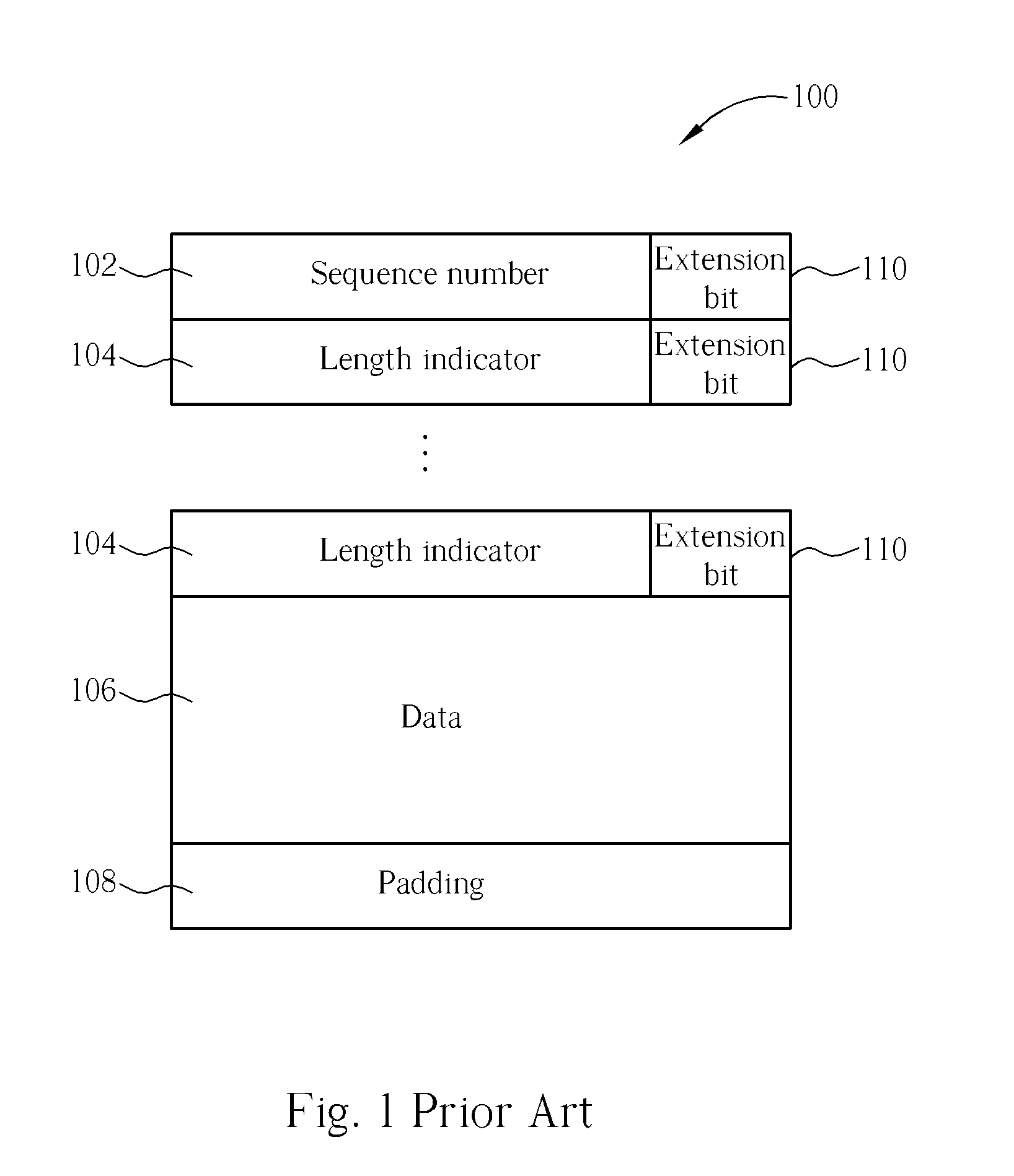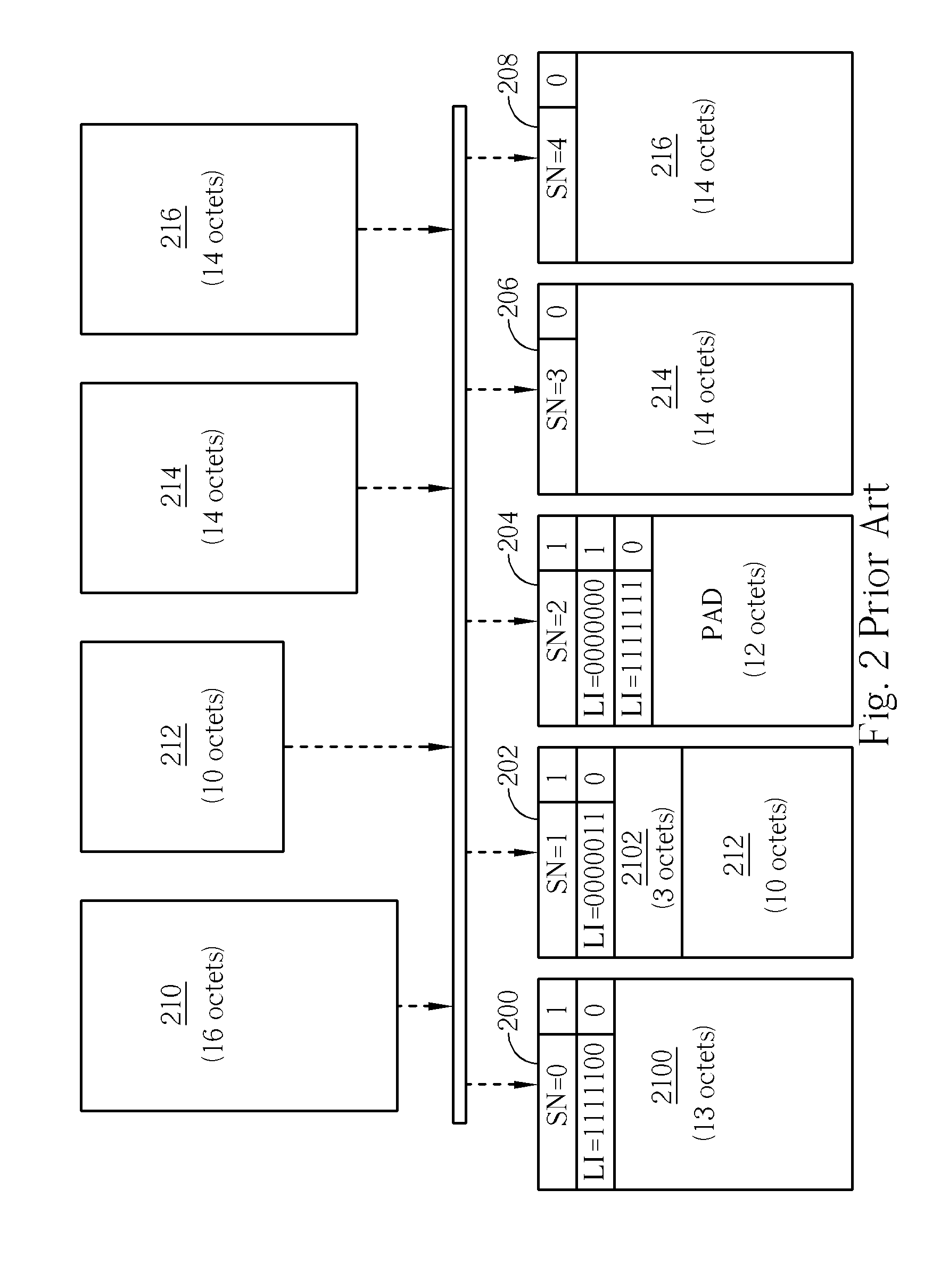Method and Apparatus of Data Segmentation in a Mobile Communications System
a mobile communications system and data segmentation technology, applied in the direction of network traffic/resource management, wireless network protocols, assess restrictions, etc., can solve the problems of system resources being wasted, transmission efficiency lowered, and low transmission bandwidth efficiency
- Summary
- Abstract
- Description
- Claims
- Application Information
AI Technical Summary
Problems solved by technology
Method used
Image
Examples
first embodiment
[0027] Please refer to FIG. 3. FIG. 3 is a flow chart of a procedure 30 of a first embodiment for data segmentation in a mobile communications system of the present invention. The procedure 30 can be compiled into the data segmentation program code 911 and comprises the following steps.
[0028] Step 300: start.
[0029] Step 301: initiate an Alternate Extension-bit Interpretation.
[0030] Step 302: determine whether the last segment of an SDU ends exactly at the end of a PDU. If so, go to step 304. If not, go to step 310.
[0031] Step 304: determine whether there is no Length Indicator field in the PDU indicating the ending location of the SDU. If none exists, go to step 306. If one is found, go to step 310.
[0032] Step 306: determine whether the length of the next SDU exactly fills the next PDU. If not, go to step 308. If the length of the next SDU exactly fills the next PDU, go to step 310.
[0033] Step 308: set a value of the first Length Indicator field of the next PDU to be a specifie...
second embodiment
[0036] Please refer to FIG. 4. FIG. 4 is a flow chart of a procedure 40 of a second embodiment for data segmentation in a mobile communications system of the present invention. The procedure 40 can be compiled into the data segmentation program code 911 and comprises the following steps:
[0037] Step 400: start.
[0038] Step 401: initiate an Alternate Extension-bit Interpretation.
[0039] Step 402: determine whether the last segment of an SDU exactly ends at the end of a PDU. If so, go to step 404. If not, go to step 410.
[0040] Step 404: determine whether there is no Length Indicator field in the PDU indicating the ending location of the SDU. If none exists, go to step 406. Else, go to step 410.
[0041] Step 406: determine whether the length of the next SDU exactly fills the next PDU. If yes, go to step 408. Else, go to step 410.
[0042] Step 408: set the first Extension bit field of the next PDU to 0 for indicating that the next PDU comprises a complete SDU that is not segmented, concat...
third embodiment
[0045] Please refer to FIG. 5. FIG. 5 is a flow chart of a procedure 60 of a third embodiment for data segmentation in a mobile communications system of the present invention. The procedure 60 can be compiled into the data segmentation program code 911, and comprises the following steps:
[0046] Step 600: start.
[0047] Step 601: initiate an Alternate Extension-bit Interpretation.
[0048] Step 602: receive a PDU.
[0049] Step 603: determine whether the PDU comprises a segment of a first SDU and does not indicate the ending location of the first SDU. If so, go to step 604. If not, go to step 614.
[0050] Step 604: receive a next PDU.
[0051] Step 606: determine whether the first extension bit of the next PDU equals 0. If so, go to step 608. If not, go to step614.
[0052] Step 608: the first SDU exactly ends at the end of the PDU, and the next PDU comprises a second SDU, which is not segmented, concatenated or padded.
[0053] Step 610: deliver the first SDU to an upper layer.
[0054] Step 612: ...
PUM
 Login to View More
Login to View More Abstract
Description
Claims
Application Information
 Login to View More
Login to View More - R&D
- Intellectual Property
- Life Sciences
- Materials
- Tech Scout
- Unparalleled Data Quality
- Higher Quality Content
- 60% Fewer Hallucinations
Browse by: Latest US Patents, China's latest patents, Technical Efficacy Thesaurus, Application Domain, Technology Topic, Popular Technical Reports.
© 2025 PatSnap. All rights reserved.Legal|Privacy policy|Modern Slavery Act Transparency Statement|Sitemap|About US| Contact US: help@patsnap.com



